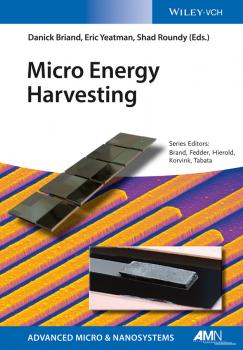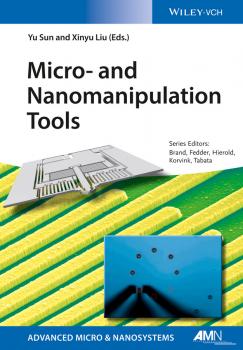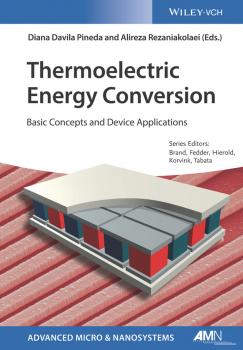MREADZ.COM - много разных книг на любой вкус
Скачивание или чтение онлайн электронных книг.Micro Energy Harvesting
With its inclusion of the fundamentals, systems and applications, this reference provides readers with the basics of micro energy conversion along with expert knowledge on system electronics and real-life microdevices. The authors address different aspects of energy harvesting at the micro scale with a focus on miniaturized and microfabricated devices. Along the way they provide an overview of the field by compiling knowledge on the design, materials development, device realization and aspects of system integration, covering emerging technologies, as well as applications in power management, energy storage, medicine and low-power system electronics. In addition, they survey the energy harvesting principles based on chemical, thermal, mechanical, as well as hybrid and nanotechnology approaches. In unparalleled detail this volume presents the complete picture – and a peek into the future – of micro-powered microsystems.
Part 2 MRCOG: Single Best Answer Questions
Part 2 MRCOG: SBA Questions contains invaluable preparation and practice for candidates undertaking the Royal College of Obstetricians and Gynaecologists Part 2 MRCOG examination. It contains 400 practice questions written by a highly experienced team of MRCOG question writers, alongside detailed answers referencing each question to either an RCOG, NICE or WHO guideline, or an article in the professional journal ‘The Obstetrician & Gynaecologist’. This will enable candidates to understand the reasoning and knowledge base behind the question, as well as giving them a clear reference should they wish to read further around the subject. The first part of the book introduces and explains the new format of the Part 2 MRCOG exam, giving insightful advice on the skills required to write a good SBA question. The second part of the book contains chapters matched to the 15 of the 19 modules of the core curriculum, giving a comprehensive range of questions and answers with detailed explanations and references. For anyone preparing for the Part 2 MRCOG exam, this book will provide extensive and comprehensive practice and guidance from an expert author team.
Total Survey Error in Practice
Featuring a timely presentation of total survey error (TSE), this edited volume introduces valuable tools for understanding and improving survey data quality in the context of evolving large-scale data sets This book provides an overview of the TSE framework and current TSE research as related to survey design, data collection, estimation, and analysis. It recognizes that survey data affects many public policy and business decisions and thus focuses on the framework for understanding and improving survey data quality. The book also addresses issues with data quality in official statistics and in social, opinion, and market research as these fields continue to evolve, leading to larger and messier data sets. This perspective challenges survey organizations to find ways to collect and process data more efficiently without sacrificing quality. The volume consists of the most up-to-date research and reporting from over 70 contributors representing the best academics and researchers from a range of fields. The chapters are broken out into five main sections: The Concept of TSE and the TSE Paradigm, Implications for Survey Design, Data Collection and Data Processing Applications, Evaluation and Improvement, and Estimation and Analysis. Each chapter introduces and examines multiple error sources, such as sampling error, measurement error, and nonresponse error, which often offer the greatest risks to data quality, while also encouraging readers not to lose sight of the less commonly studied error sources, such as coverage error, processing error, and specification error. The book also notes the relationships between errors and the ways in which efforts to reduce one type can increase another, resulting in an estimate with larger total error. This book: • Features various error sources, and the complex relationships between them, in 25 high-quality chapters on the most up-to-date research in the field of TSE • Provides comprehensive reviews of the literature on error sources as well as data collection approaches and estimation methods to reduce their effects • Presents examples of recent international events that demonstrate the effects of data error, the importance of survey data quality, and the real-world issues that arise from these errors • Spans the four pillars of the total survey error paradigm (design, data collection, evaluation and analysis) to address key data quality issues in official statistics and survey research Total Survey Error in Practice is a reference for survey researchers and data scientists in research areas that include social science, public opinion, public policy, and business. It can also be used as a textbook or supplementary material for a graduate-level course in survey research methods. Paul P. Biemer, PhD, is distinguished fellow at RTI International and associate director of Survey Research and Development at the Odum Institute, University of North Carolina, USA. Edith de Leeuw, PhD, is professor of survey methodology in the Department of Methodology and Statistics at Utrecht University, the Netherlands. Stephanie Eckman, PhD, is fellow at RTI International, USA. Brad Edwards is vice president, director of Field Services, and deputy area director at Westat, USA. Frauke Kreuter, PhD, is professor and director of the Joint Program in Survey Methodology, University of Maryland, USA; professor of statistics and methodology at the University of Mannheim, Germany; and head of the Statistical Methods Research Department at the Institute for Employment Research, Germany. Lars E. Lyberg, PhD, is senior advisor at Inizio, Sweden. N. Clyde Tucker, PhD, is principal survey methodologist at the American Institutes for Research, USA. Brady T. West, PhD, is research associate professor in the Survey Resea
Ceramics for Environmental Systems
This volume contains a collection of 14 papers submitted from the below five symposia held during the 11th International Symposium on Ceramic Materials and Components for Energy and Environmental Applications (CMCEE-11), June 14-19, 2015 in Vancouver, BC, Canada: Photocatalysts for Energy and Environmental Applications Advanced Functional Materials, Devices, and Systems for the Environment Geopolymers, Inorganic Polymer Ceramics and Sustainable Composites Macroporous Ceramics For Environmental and Energy Applications Advanced Sensors for Energy, Environment, and Health Applications
How College Affects Students. 21st Century Evidence that Higher Education Works
The bestselling analysis of higher education's impact, updated with the latest data How College Affects Students synthesizes over 1,800 individual research investigations to provide a deeper understanding of how the undergraduate experience affects student populations. Volume 3 contains the findings accumulated between 2002 and 2013, covering diverse aspects of college impact, including cognitive and moral development, attitudes and values, psychosocial change, educational attainment, and the economic, career, and quality of life outcomes after college. Each chapter compares current findings with those of Volumes 1 and 2 (covering 1967 to 2001) and highlights the extent of agreement and disagreement in research findings over the past 45 years. The structure of each chapter allows readers to understand if and how college works and, of equal importance, for whom does it work. This book is an invaluable resource for administrators, faculty, policymakers, and student affairs practitioners, and provides key insight into the impact of their work. Higher education is under more intense scrutiny than ever before, and understanding its impact on students is critical for shaping the way forward. This book distills important research on a broad array of topics to provide a cohesive picture of student experiences and outcomes by: Reviewing a decade's worth of research; Comparing current findings with those of past decades; Examining a multifaceted analysis of higher education's impact; and Informing policy and practice with empirical evidence Amidst the current introspection and skepticism surrounding higher education, there is a massive body of research that must be synthesized to enhance understanding of college's effects. How College Affects Students compiles, organizes, and distills this information in one place, and makes it available to research and practitioner audiences; Volume 3 provides insight on the past decade, with the expert analysis characteristic of this seminal work.
Micro- and Nanomanipulation Tools
Combining robotics with nanotechnology, this ready reference summarizes the fundamentals and emerging applications in this fascinating research field. This is the first book to introduce tools specifically designed and made for manipulating micro- and nanometer-sized objects, and presents such examples as semiconductor packaging and clinical diagnostics as well as surgery. The first part discusses various topics of on-chip and device-based micro- and nanomanipulation, including the use of acoustic, magnetic, optical or dielectrophoretic fields, while surface-driven and high-speed microfluidic manipulation for biophysical applications are also covered. In the second part of the book, the main focus is on microrobotic tools. Alongside magnetic micromanipulators, bacteria and untethered, chapters also discuss silicon nano- and integrated optical tweezers. The book closes with a number of chapters on nanomanipulation using AFM and nanocoils under optical and electron microscopes. Exciting images from the tiniest robotic systems at the nano-level are used to illustrate the examples throughout the work. A must-have book for readers with a background ranging from engineering to nanotechnology.
Thermoelectric Energy Conversion. Basic Concepts and Device Applications
The latest volume in the well-established AMN series, this ready reference provides an up-to-date, self-contained summary of recent developments in the technologies and systems for thermoelectricity. Following an initial chapter that introduces the fundamentals and principles of thermoelectricity, subsequent chapters discuss the synthesis and integration of various bulk thermoelectric as well as nanostructured materials. The book then goes on to discuss characterization techniques, including various light and mechanic microscopy techniques, while also summarizing applications for thermoelectric materials, such as micro- and nano-thermoelectric generators, wearable electronics and energy conversion devices. The result is a bridge between industry and scientific researchers seeking to develop thermoelectric generators.
Teaching and Supervising Cognitive Behavioral Therapy
A total CBT training solution, with practical strategies for improving educational outcomes. Teaching and Supervising Cognitive Behavioral Therapy is the first comprehensive package to provide empirically-validated CBT training and supervisory techniques. Applicable to a variety of behavioral health care disciplines, this multi-modal guide provides educators with the information and tools that can help improve educational outcomes. An examination of CBT developments over the past twenty years leads into a discussion of practical applications for improving CBT education, while addressing the technological advances that facilitate dissemination and the specific challenges posed to confidentiality and patient care. The digital component contains additional audio and video content, plus downloadable worksheets that reinforce and expand upon the strategies presented. Coverage includes advice geared specifically toward the most commonly-encountered problems, with video of training sessions that address issues like frustration with patients, disbelief in psychotherapy, dislike of the method, and lack of skills. Readers will gain insight into effective goal setting, and implement a structured approach to supervision. Examine existing literature and research on training, supervision, and evaluation Integrate theory with practical strategies to improve learning outcomes Customize training approaches to specifically suit different professional groups Fit the methods to the environment, including workshops, webinars, and podcasts Mental health professionals who favor an empirically-based approach to therapy will appreciate the effectiveness of an empirically-based approach to pedagogy. Backed by over two decades of CBT research and the insight of leading CBT experts, Teaching and Supervising Cognitive Behavioral Therapy provides trainers with the tools and information they need to improve therapist educational outcomes.
Geochronology and Thermochronology
This book is a welcome introduction and reference for users and innovators in geochronology. It provides modern perspectives on the current state-of-the art in most of the principal areas of geochronology and thermochronology, while recognizing that they are changing at a fast pace. It emphasizes fundamentals and systematics, historical perspective, analytical methods, data interpretation, and some applications chosen from the literature. This book complements existing coverage by expanding on those parts of isotope geochemistry that are concerned with dates and rates and insights into Earth and planetary science that come from temporal perspectives. Geochronology and Thermochronology offers chapters covering: Foundations of Radioisotopic Dating; Analytical Methods; Interpretational Approaches: Making Sense of Data; Diffusion and Thermochronologic Interpretations; Rb-Sr, Sm-Nd, Lu-Hf; Re-Os and Pt-Os; U-Th-Pb Geochronology and Thermochronology; The K-Ar and 40Ar/39Ar Systems; Radiation-damage Methods of Geo- and Thermochronology; The (U-Th)/He System; Uranium-series Geochronology; Cosmogenic Nuclides; and Extinct Radionuclide Chronology. Offers a foundation for understanding each of the methods and for illuminating directions that will be important in the near future Presents the fundamentals, perspectives, and opportunities in modern geochronology in a way that inspires further innovation, creative technique development, and applications Provides references to rapidly evolving topics that will enable readers to pursue future developments Geochronology and Thermochronology is designed for graduate and upper-level undergraduate students with a solid background in mathematics, geochemistry, and geology.
Electrohydraulic Fracturing of Rocks
This book presents a new fracturing technique that should be considered as a potential alternative, or a companion technique, to hydraulic fracturing of tight gas reservoirs and low permeability rock masses. As opposed to hydraulic fracturing which generates a few numbers of large cracks, electro-hydraulic fracturing induces diffuse micro-cracking and fragmentation of rocks. Laboratory tests demonstrate that increases of permeability by two orders of magnitude can be reached, without major cracking in tested specimens. This book discusses the principles of this new technique, reports experiments which have been developed is order to prove the concept and finally describes the numerical model from which the potentialities of this technique in representative reservoir conditions can be assessed.









